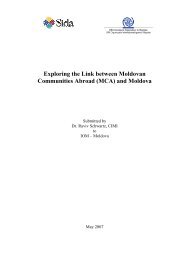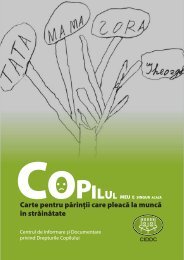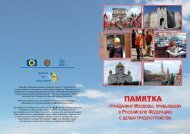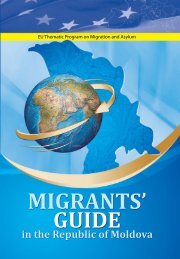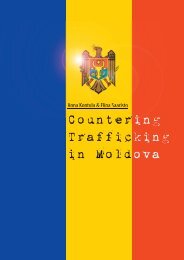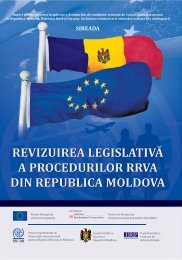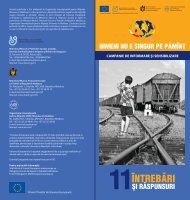Trafficking in Human Beings in Southeastern Europe - Iom
Trafficking in Human Beings in Southeastern Europe - Iom
Trafficking in Human Beings in Southeastern Europe - Iom
- No tags were found...
Create successful ePaper yourself
Turn your PDF publications into a flip-book with our unique Google optimized e-Paper software.
<strong>Traffick<strong>in</strong>g</strong> <strong>in</strong> <strong>Human</strong> Be<strong>in</strong>gs<strong>in</strong> <strong>Southeastern</strong> <strong>Europe</strong>tioned approximately 600 women. Three hundred of them were judged to betrafficked.The police practice is not to deta<strong>in</strong> any women who have valid documents andhave not committed any crime, but simply to leave them <strong>in</strong> the brothels.Women without valid documents and those who have committed crimes (whomust first serve any sentence), are taken by the police to the Federal ReceptionCentre for Foreign Citizens (the detention centre for illegal migrants) <strong>in</strong>Pad<strong>in</strong>ska Skela. Women, who are judged to be victims of traffick<strong>in</strong>g – accord<strong>in</strong>gto the police <strong>in</strong>vestigation and on the basis of their own statement - mustsign a statement confirm<strong>in</strong>g that they are victims of traffick<strong>in</strong>g and want to bevoluntarily repatriated. These women are not prosecuted for illegal statusoffences and are expected to testify aga<strong>in</strong>st traffickers.Republic ofSerbia(exclud<strong>in</strong>gKosovo)Those not judged to be trafficked persons are accused of illegal stay <strong>in</strong> thecountry and can be sentenced to up to 60 days <strong>in</strong> the detention centre priorto deportation. Although <strong>in</strong> pr<strong>in</strong>ciple women can also be charged with prostitution,<strong>in</strong> practice this is not done. No witness protection programme exists,and trafficked women who do not wish to be repatriated to their countries oforig<strong>in</strong> are treated as illegal migrants, arrested, deta<strong>in</strong>ed and deported to theborder.In July 2001, the Federal M<strong>in</strong>istry of the Interior allocated space <strong>in</strong> the FederalReception Centre for Foreign Citizens <strong>in</strong> Pad<strong>in</strong>ska Skela as a temporary shelterfor trafficked persons who qualify for IOM support. IOM-tra<strong>in</strong>ed staff <strong>in</strong>terviewall referred women to asses their eligibility for the return programme. 90Women who are not eligible for the IOM programme are deported from theshelter to the border. Those that are covered by IOM programme are assistedto return to their country of orig<strong>in</strong> once their travel documents have beenarranged. At the moment IOM only organises basic counsell<strong>in</strong>g for traffickedwomen. Basic medical treatment is provided on request at the Federal ReceptionCentre for Foreign Citizens. International organisations and NGOs thatwork with trafficked women have to ask the Federal M<strong>in</strong>istry of the Interiorofficially for permission to enter the Federal Reception Centre for Foreign Citizens,which <strong>in</strong> practice means they have no access to the detention centre.Accord<strong>in</strong>g to the police, women refuse to participate <strong>in</strong> the IOM programmenot only because they do not wish to go back home, but also because they areafraid to be recognised as prostitutes once they go back. The Moldavian press,for example, published some articles about IOM activities <strong>in</strong> Moldova, whichpublicly condemned women who return to Moldova with IOM support as prostitutes.1.4. ProsecutionAccord<strong>in</strong>g to the Crim<strong>in</strong>al Code of Serbia and of FRY, traffick<strong>in</strong>g is not a specificcrim<strong>in</strong>al offence. However, traffick<strong>in</strong>g is covered by the section on slavery,under Article 155, which perta<strong>in</strong>s to the slavery and transportation of humanbe<strong>in</strong>gs. This crime belongs to the group of crimes aga<strong>in</strong>st humanity, coveredunder <strong>in</strong>ternational law with<strong>in</strong> the chapter on “Crim<strong>in</strong>al Acts Aga<strong>in</strong>st <strong>Human</strong>ityand Other Objects Protected by International Law.” FRY has ratified the 1926Convention on Prevention and Combat<strong>in</strong>g Slavery and the 1956 AdditionalConvention on the Elim<strong>in</strong>ation of Slavery and <strong>Traffick<strong>in</strong>g</strong> <strong>in</strong> <strong>Human</strong> Be<strong>in</strong>gs. 9190.To be eligible, women must be victims of traffick<strong>in</strong>g and will<strong>in</strong>g to return voluntarily to theirhome country.91.International Hels<strong>in</strong>ki Federation for <strong>Human</strong> Rights, Report to the OSCE Supplementary<strong>Human</strong> Dimension Meet<strong>in</strong>g on <strong>Traffick<strong>in</strong>g</strong> of <strong>Human</strong> Be<strong>in</strong>gs, A Form of Slavery: “<strong>Traffick<strong>in</strong>g</strong><strong>in</strong> Women <strong>in</strong> OSCE Member States”, 19 June 2000, p. 68.79



